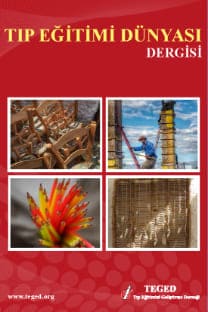Uzaktan Eğitim ile Verilen Anatomi Dersinin Değerlendirilmesi
Anatomi, Tutum, Uzaktan Eğitim, Hemşire, Paramedikal Personel
Assessment of Anatomy Course Providing Through Distance Learning System
Anatomy, Attitude, Distance Learning, Nurse, Paramedical Personnel,
___
- Abdullahi A, Gannon M. Improving college students success in gateway science courses: lessons learned from an anatomy and physiology workshop. American Journal of Health Sciences. 2012; 3(3): 159-168.
- Bahçeci D. Anatomi dersinde portfolyo kullanmanın öğrencilerin bilişsel ve duyuşsal özellikleri üzerine etkisi [Doktora Tezi]. Ankara: Gazi Üniversitesi Eğitim Bilimleri Enstitüsü. 2006.
- Kılıç Z. Beyin Temelli Öğrenme Yaklaşımının Öğrencilerin Anatomi ve Fizyoloji Dersindeki Başarı ve Tutumlarına Etkisi. The Journal of International Social Research. 2018; 11(60): 1-12.
- Kırlı M. Hemşirelik eğitiminde anatomi dersinin yeri ve önemi [Yüksek Lisans Tezi]. Afyonkarahisar: Afyon Kocatepe Üniversitesi Sağlık Bilimleri Enstitüsü; 2019.
- Çetkin M, Turhan B, Bahşi İ, Kervancıoğlu P. Tıp fakültesi öğrencilerinin anatomi eğitimi hakkındaki düşünceleri. Gaziantep Medical Journal. 2016; 22(2): 82-88.
- Tuygar Ş, Kuş İ, Saygılı Ö, Özcan E, Gülcen B. Tıp Fakültesi Öğrencilerinin Anatomi Eğitimine Yönelik Memnuniyet Düzeyleri ve İlgili Değişkenlerin İncelenmesi. Tıp Eğitimi Dünyası. 2015; 14(42): 5-14.
- Yılmaz S, Susar H, Karaca İ, Yılmaz H, Nisari M, Ertekin T. Anatomi Eğitimi Üzerine Araştırma Görevlilerinin Görüşleri. Bozok Tıp Dergisi. 2017; 7(2), 35-40.
- Tang CM, Chaw LY. Digital Literacy: A Prerequisite for Effective Learning in a Blended Learning Environment? Electronic Journal of E-learnin. 2016; 14(1): 54-65.
- Sharma S, Oli N, Thapa B. Electronic health–literacy skills among nursing students. Advances in medical education and practice. 2019;10: 527.
- Prior DD, Mazanov J, Meacheam D, Heaslip G, Hanson J. Attitude, digital literacy and self efficacy: Flow-on effects for online learning behavior. The Internet and Higher Education. 2016; 29: 91-97.
- Briones R. Harnessing the web: how e-Health and e-Health literacy impact young adults’ perceptions of online health information. Medicine 2.0. 2015; 4(2): 1-14.
- Miltiadou M, Yu CH. Validation of the Online Technologies Self-Effi cacy Scale (OTSES). 2020. Retrieved from https://files.eric.ed.gov/fulltext/ED445672.pdf
- Horzum MB, Çakır-Balta Ö. Çevrim İçi Teknolojilere Yönelik Öz Yeterlik Algısı Ölçeği Türkçe Formunun Geçerlik ve Güvenirlik Çalışması. Kuram ve Uygulamada Eğitim Bilimleri. 2009; 9(3): 1327-1356.
- Mutluay ŞD, Açıkgöz AK. Öğrenci Ebe ve Hemşirelerin Anatomi Eğitimi Hakkındaki Görüşlerinin Değerlendirilmesi. Lokman Hekim Dergisi. 2020; 10(2): 201-208.
- Erbay H, Bilir A, Gönül Y, Turamanlar O, Songur A. Medical students' perception of cadaver and, their attitudes towards using the cadaver in education. Turkish Journal of Bioethics. 2015; 2(1): 63-72.
- Behrendt M, Foster J, Machtmes K. Student Perception of How to Succeed in a Pre-Nursing Anatomy and Physiology Course. HAPS Educator. 2020; 24(2): 5-20.
- Gaur R, Mudgal SK, Kaur S, Sharma R. Undergraduate nursing students’ attitude towards online classes during lockdown period in India: imposed or interested? Int J Community Med Public Healt. 2020; 7 :3371-3777.
- Singh A, Min AK. Digital lectures for learning gross anatomy: a study of their efficacy. Korean J Med Educ. 2017; 29 :27-32.
- Isik B, Kuzudisli S. Learning anatomy of nursing and medical students 7th world conference on educational sciences, Procedia Soc. Behav. Sci. 2015; 197: 1079-1084.
- Lai HL, Perng SJ, Huang CY. Nursing Students' Perceptions of a Silent Mentor Program in an Anatomy Course. Anat Sci Educ. 2019; 12(6):627-635.
- Alhonkoskia M, Salminena L, Pakarinena A, Veermansb M. 3D technology to support teaching and learning in health care education – A scoping review. International Journal of Educational Research. 2021; 105: 101699.
- Birt J, Moore E, Cowling M. Improving paramedic distance education through mobile mixed reality simulation. Australasian Journal of Educational Technolog. 2017; 33(6): 69-83.
- Coopasami M, Knight S, Pete M. E-Learning readiness amongst nursing students at the Durban University of Technology. Health SA Gesondheid. 2017; 22, 300-306.
- ISSN: 1303-328X
- Yayın Aralığı: 3
- Başlangıç: 2000
- Yayıncı: Tıp Eğitimini Geliştirme Derneği
Funda TAYFUN KÜPESİZ, Erol GÜRPINAR
Tıp Fakültesi ve Diş Hekimliği Fakültesi Öğrencilerinin Anatomi Dersi Ödevlerinde Kaynak Kullanımı
Aynı Üniversite Kliniğinden Mezun Olan Göğüs Hastalıkları Uzmanlarının Bronkoskopi Yetkinlikleri
Albena GAYEF, Haydar Celal KARLIKAYA
Uzaktan Eğitim ile Verilen Anatomi Dersinin Değerlendirilmesi
İlknur DOLU, Hacer YALNIZ DİLCEN
Funda TAYFUN KÜPESİZ, Erol GÜRPINAR
Yusuf Kemal ARSLAN, Mergül ÇOLAK, Ulviye BİLGİN
Tıp Fakültesi İntörnlerinin Toplum Sağlığı Merkezleri Hakkında Bilgi ve Görüşleri
